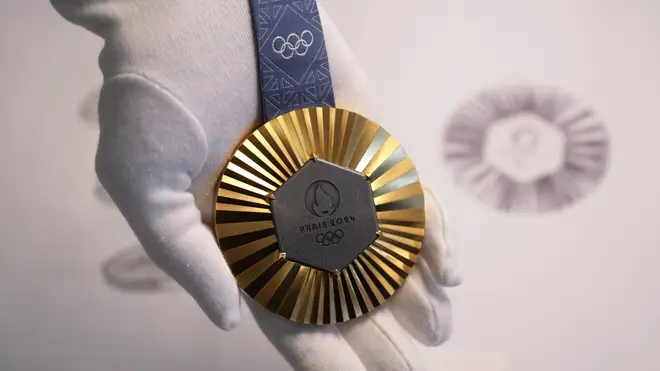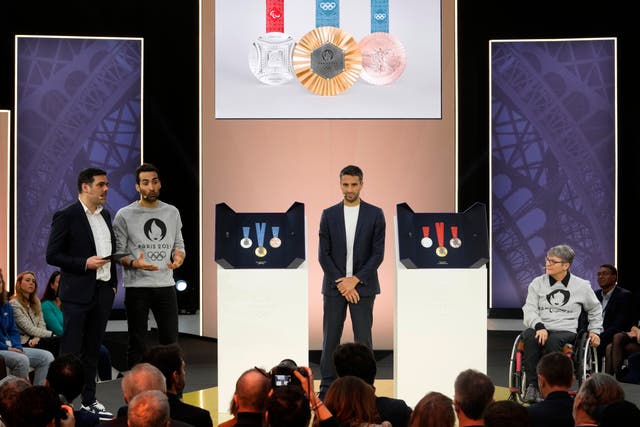
Nick Ferrari 7am - 10am
8 February 2024, 12:04

The iron pieces embedded in the centre of the Olympic medals each weigh 18 grams.
Medals at the Paris 2024 Olympics will be inlaid with pieces of the Eiffel Tower.
A hexagonal, polished chunk of iron taken from the famous French landmark is being embedded in each gold, silver and bronze medal that will be hung around athletes’ necks at the July 26-August 11 Paris Games and Paralympics that follow.
Games organisers revealed their revolutionary design on Thursday.
The iron pieces embedded in the centre of the Olympic medals each weigh 18 grams (about two-thirds of an ounce).

They were cut from girders and other bits that were swapped out of the Eiffel Tower during renovations and stored for safekeeping, according to Joachim Roncin, head of design at the Paris Games Organising Committee.
“The concept came after a few discussions. We realised that there’s one symbol known across the world, which is the Eiffel Tower,” Mr Roncin said.
“We said to ourselves, ‘Hey, what if we approached the Eiffel Tower Operating Company to see if it’s possible to get a bit of the Eiffel Tower to integrate into the medal?’”
The company agreed, and “the dream became reality”, he said.
“It’s really a bit of metal from the Eiffel Tower.”
The chunks were stripped of paint, polished and varnished for their second life.

They are stamped with “Paris 2024” and the Games logo – which looks like a flame or the face of a woman with a chic bob haircut.
The five Olympic rings are also stamped on the iron of the Olympic medals.
The Paralympic logo of three swooshes, known as the Agitos, is stamped on the medals for the August 28-September 8 Paralympics.
The iron pieces’ hexagonal form represents France.
The French sometimes refer to their country as “L’Hexagone” – the hexagon – because of its shape.
Paris jewellery house Chaumet designed the medals.
Six small clasps that hold the iron pieces in the medals are a wink at the 2.5 million rivets that bind the Eiffel Tower together.

Around the iron pieces are discs of gold, silver or bronze.
They are crinkled to reflect the light, making the medals shine.
Games organisers said the metal is all recycled, not newly mined.
“Having a gold medal is already something incredible. But we wanted to add this French touch and we thought that the Eiffel Tower would be this cherry on the top,” Mr Roncin said.
“Having a piece of it is a piece of history.”
The ancient Greek goddess of victory, Nike, features on the Olympic medals’ other side – as she has done at every Games since 1928.
But Paris has also added a small representation of the Eiffel Tower on that side, in another break with tradition.

The other side of the Paralympic medals shows a view of the tower as if looking upward from underneath.
For visually impaired people, “Paris 2024” is written in Braille and the edges have notches: one for gold, two for silver, three for bronze.
The Paris Mint is manufacturing 5,084 medals – about 2,600 for the Olympics and 2,400 for the Paralympics.
That is likely to be more than will be required.
Some will be stored in case medals need to reassigned after the Games, which can happen when medal winners are subsequently stripped of the prizes for doping.
Some go to museums.
Any other spares could be destroyed.
The gold medals weigh 529 grams and are not pure gold.

They are made of silver and plated with six grams of gold.
The silvers weigh 525 grams.
The bronzes weigh 455 grams and are a copper, tin and zinc alloy.
The medals are 85 millimetres across and 9.2 millimetres thick.
They will come in a dark-blue box from Chaumet and a certificate from the Eiffel Tower Operating Company stating that the iron pieces came from the monument.
Paris organisers did not give a monetary value for the medals.